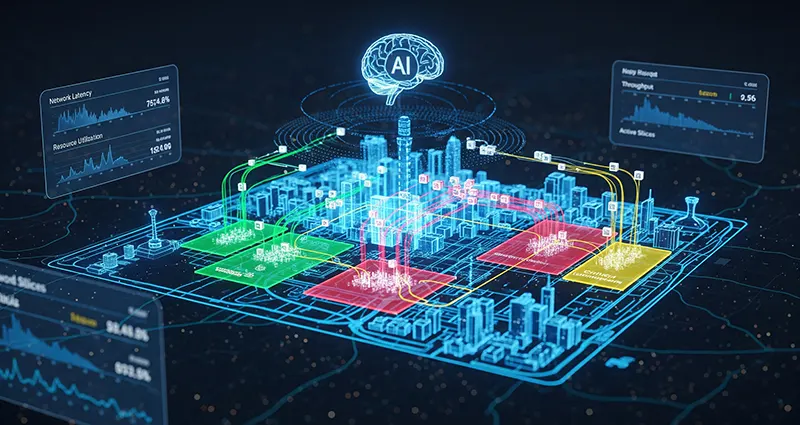The advent of 5G technology promises unprecedented connectivity speeds, ultra-low latency, and massive device support that will revolutionize industries and user experiences alike. To fully unlock the potential of 5G networks, innovative approaches like network slicing and dynamic resource orchestration are essential. When powered by artificial intelligence (AI), these technologies enable intelligent, adaptive management of network resources, ensuring enhanced performance, reliability, and efficiency.
Understanding 5G Network Slicing
Network slicing is a fundamental feature of 5G that allows a single physical network infrastructure to be partitioned into multiple virtual networks or “slices,” each tailored to specific use cases or service requirements. For example, different slices may cater to enhanced mobile broadband (eMBB), ultra-reliable low latency communications (URLLC), or massive machine-type communications (mMTC).
Each slice operates independently with customized resources, quality of service (QoS), and security policies, enabling operators to serve diverse applications simultaneously without compromising performance.
The Role of Dynamic Resource Orchestration
Resource orchestration involves the automated management and allocation of network resources—such as bandwidth, computing power, and storage—across various network slices. Dynamic orchestration adjusts these allocations in real time based on network conditions, user demands, and service-level agreements (SLAs).
Dynamic resource orchestration is vital for maintaining network efficiency and meeting varying traffic patterns, especially in scenarios like smart cities, autonomous vehicles, and industrial automation where reliability and responsiveness are critical.
How AI Enhances 5G Network Slicing and Orchestration
Artificial intelligence introduces advanced capabilities to 5G network management by enabling:
- Predictive Analytics: AI models analyze historical and real-time data to forecast traffic trends and potential network congestion, allowing proactive resource allocation.
- Automated Decision-Making: Machine learning algorithms can autonomously make complex decisions regarding slice creation, modification, and resource distribution without human intervention.
- Adaptive and Context-Aware Management: AI enables networks to dynamically adapt to environmental changes, user mobility, and application requirements, optimizing performance continuously.
- Fault Detection and Self-Healing: Intelligent systems can swiftly identify anomalies or faults in network slices and trigger corrective actions to maintain service quality.
- Energy Efficiency: AI optimizes resource usage, reducing energy consumption by scaling resources up or down precisely as needed.
Benefits of AI-Powered Network Slicing and Orchestration
- Enhanced User Experience: Tailored slices guarantee that applications receive the appropriate network characteristics such as bandwidth, latency, and reliability, ensuring seamless performance.
- Improved Resource Utilization: Dynamic orchestration maximizes the utilization of physical infrastructure, reducing operational costs.
- Scalability: AI-driven automation facilitates quick scaling of network slices to accommodate growing or fluctuating demands.
- Faster Service Deployment: New services and slices can be provisioned rapidly, driving innovation and agility.
- Robust Security: AI can monitor network traffic within slices to detect threats and enforce security policies effectively.
Challenges and Considerations
While AI-powered 5G network slicing and orchestration offer promising advantages, several challenges persist:
- Complexity of AI Models: Developing accurate and efficient AI algorithms that can operate in real-time environments is demanding.
- Interoperability: Seamless integration with existing network functions and multi-vendor environments requires standardization.
- Data Privacy: Managing vast amounts of data for AI training and operation must comply with privacy regulations.
- Computational Overhead: Running AI models may introduce additional processing requirements impacting latency.
Future Outlook
The convergence of AI and 5G network slicing with dynamic resource orchestration is a game-changer for telecommunications. As AI techniques mature and 5G deployments expand globally, networks will become increasingly intelligent, autonomous, and adaptable.
Research efforts continue to focus on enhancing AI algorithms’ accuracy, reducing computational demands, and developing open frameworks for orchestration. Ultimately, AI-powered 5G networks will empower new applications like virtual reality, remote surgery, and massive IoT ecosystems with the performance and reliability they demand.
AI-powered 5G network slicing and dynamic resource orchestration represent a critical evolution in network management, providing the agility and intelligence necessary for next-generation connectivity. By enabling precise, real-time control over virtualized network resources, this combination ensures enhanced performance, improved user experiences, and optimized operational efficiency—paving the way for a smarter and more connected future.











